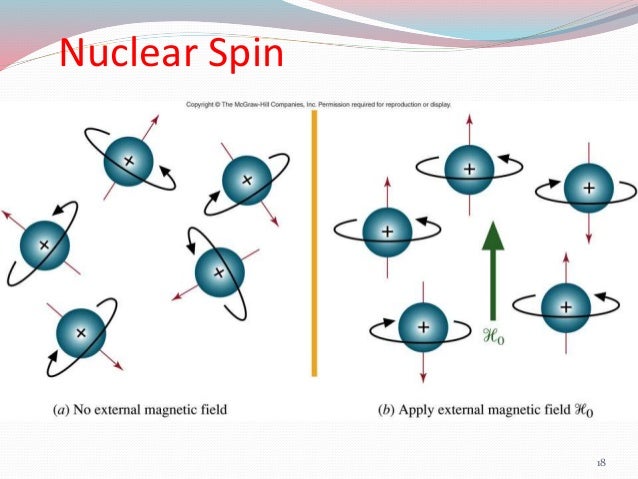Signal Generation
Purpose
The purpose of this discussion is to give you a basic understanding of the underlying physics of MRI signal generation and acquisition.
Objectives
- Be able to explain how a signal is generated during an MRI study.
Signal Generation
Nuclear Spin

- Spin - the magnetic moment and angular momentum of a proton caused by electrical current on a proton.
- Lamour frequency - the rate at which charge "rotates" across a proton.
- Atom specific
- Precession - the gyroscopic motion of a spinning object.
Spin in an external magnetic field
- The axis of precession will align with any external magnetic field.
- Parallel state – a low energy state. The axis is in alignment with the external magnetic field.
- Antiparallel state – a high energy state. The axis is in an opposing alignment (not perpendicular) with the external magnetic field.

Magnetizing a spin system
- MRI does not measure individual protons (otherwise I could do far more with it!).
- MRI measures the net magnetization (M) of matter in a defined space.
- M is a vector with two components:
- longitudinal – parallel and antiparallel to M.
- transverse – perpendicular to M.
- Transverse component cancels out.
- Longitudinal can be measured as the proportion of all parallel and antiparallel spins.
Excitation
- An electromagnetic pulse is applied to matter in an external magnetic field.
- Protons absorb that energy.
- The ratio of parallel to antiparallel protons changes.
- A 90° pulse results in a 1 to 1 ratio.
- A 180° pulse results in a ratio favoring the antiparallel state.
- When the pulse stops, protons release electromagnetic energy (called relaxation) and return to their previous orientation.
Relaxation
- Relaxation – protons return to their original orientation after the excitation pulse has ended.
- Transverse relaxation – the loss of magnetization perpendicular to the magnetic field.
- T2 decay – a time constant describing transverse relaxation related to spin-spin differences.
- T2* decay – a time constant describing transverse relaxation resulting from spin-spin differences and local inhomogeneities in the magnetic field.
- Longitudinal relaxation – the return of net magnetization parallel to the magnetic field.
- T1 – a time constant describing the the recovery of the longitudinal component of net magnetization.
- Transverse relaxation – the loss of magnetization perpendicular to the magnetic field.
- These time constants are used to determine when an MR signal is recorded and affect image contrast.